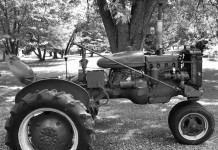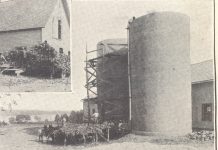
(Read to bottom for Parts 2 and 3 of this three-part series.)
The media today is full of speculation about the possibilities of a woman becoming President of the United States. Ninety-seven years ago this month, the U.S. media was all agog about the first woman to actually drive a car from coast to coast. Unheard of.
Too fragile
Women are far too fragile to stand the rigors of such a journey and certainly lacked the mechanical ability and common sense needed for such a venture (please, ladies, don’t get all up in arms. I’m only stating the common knowledge of the day, at least among men). Also bear in mind that a Vermont doctor named Horatio Nelson Jackson had been the very first man to drive a car from coast to coast. He had done it only six years earlier — in 1903 to win a $50 bet.
Alice gets a car
Born in Hackensack, New Jersey, in 1886, Alice Huyler was interested in things mechanical from an early age. After two years at Vassar College she left to marry a lawyer more than twice her age named John Rathbone Ramsey.
In the early spring of 1908, while taking one of the family horses for a drive, a passing car spooked the animal and he bolted. With some difficulty Alice got him under control, but the episode frightened her husband and he bought her a “shining red Maxwell roadster with two bucket seats in front and a fold down jump seat in the rear,” as Alice described it. The Maxwell agent gave Alice two lessons and pronounced her a capable driver.
Turning heads
Alice loved to drive and put 6,000 miles on the little red car that summer exploring the roads around New Jersey, becoming an expert driver. So much so, that she entered a reliability run that fall that ran 150 miles from Lynbrook to Montauk Point on Long Island. She completed the run successfully and caught the eye of Carl Kelsey who was sales manager for Maxwell-Briscoe.
That very night Kelsey proposed to make Alice “the first woman ever to drive an automobile across the United States of America, from Hell Gate on the Atlantic to the Golden Gate on the Pacific — and in a Maxwell!”

Travel companions
As can be imagined, the idea took Alice Ramsey’s breath away; not quite 22, such a thing at first seemed impossible, but the more she thought of it the more she liked it. Her two older married sisters-in-law had accompanied her on the Montauk run and had heard Kelsey’s proposal.
On the way back to Hackensack they discussed it and indicated a willingness to accompany Alice — but what would her husband say? In the end, with the assurance that his sisters would go along, Ramsey agreed and a fourth passenger, a younger friend of Alice, was enlisted.
Maxwell-Briscoe furnished a new 1909 Maxwell 30 touring car and agreed to pay all expenses. They also alerted all the Maxwell dealers along the way to watch for the car and assist in any way. Wanting to milk the trip for all possible publicity, the company hired a newspaperman as advance agent and he traveled the route by train, making arrangements for lodging and welcoming parties, and interviewing the girls each day for their impressions.
Travel attire
The trip was scheduled to begin on June 9, 1909 at the Maxwell showroom on Broadway in New York City, and the girls were in a quandary as to what to take and how to pack it into the single suitcase allotted to each — the long dresses then worn took a lot of space. They each took extra underwear, toiletries, and a dressy suit, blouse or two and shoes, and all of them but Alice managed to secret one of the large flowery hats popular at the time (Alice was stuck with wearing her visored driving cap on the few occasions they dressed up).
For everyday travel they chose tan covert suits with plain blouses, over which they wore long dusters in nice weather and driving caps with visors and soft, billowing crowns that were tied on with long veils that tied under the chin. Although the Maxwell had a waterproof top that could be raised, there were no side curtains so rubber hats and ponchos were a necessity.
Supplies
The car had been equipped with a larger, 20-gallon gas tank and carried tools, hand tire pump, jack, two spare tire casings, and extra inner tubes and patching equipment, along with a picnic hamper with a few rations and eating utensils. The headlights burned acetylene gas, which was made by a carbide generator on the left running board, while the cowl and tail lights burned kerosene. To warn pedestrians and other drivers, there was a brass horn with the bulb conveniently at the driver’s right hand. Treaded tires were still in the future, so tire chains and lots of repair links and spare cross chains were carried and used frequently — even in rainy weather, as the smooth tires gave little purchase on slippery surfaces.
About the car
The Maxwell 30 was right-hand drive, had a 30-horsepower, 4-cylinder engine, and drove the rear wheels through a 3-speed and reverse transmission, a driveshaft and a differential. It weighed a little over 2,000 pounds unloaded, and the top speed was around 40 mph. Alice’s car had black fenders, a dark green body, and a black folding top. It also had a sheet iron pan underneath the engine to protect from road damage.
Women only
Alice was the only one of the four women who knew how to drive so she would be behind the wheel the whole way and, as Maxwell advertised the trip as “a women only” venture, she had to crank the engine, change tires, and make minor repairs along the way. June 9 was a chilly day with a steady rain falling, as the four ladies, elegant in their rubber ponchos, posed for pictures and answered questions from the many bystanders who had come to watch the strange sight of four women taking off for the west coast in an automobile — I imagine there were more than a few bets placed on the outcome.
Finally at about 10 a.m., Alice gave the Maxwell’s crank a pull, the engine roared to life, and they were off. I’ll tell you some highlights of the journey next time.
Related Coverage












